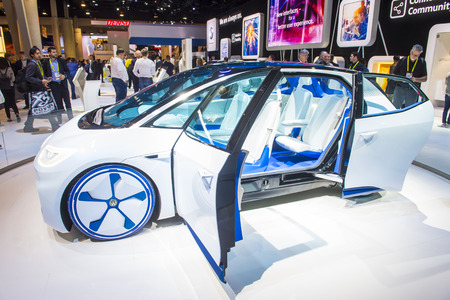1. Introduction: The Spirit of Atmanirbhar Bharat in Auto Tech
The Auto Expo 2025 is not just another global automotive exhibition—it stands as a testament to India’s unwavering commitment towards Atmanirbhar Bharat, or self-reliant India. This year, the country’s bold vision for technological sovereignty takes centre stage, with a vibrant showcase of innovations that are conceptualised, designed, and manufactured entirely within the subcontinent. As Indian automakers and startups unveil cutting-edge features and smart mobility solutions born from local ingenuity, the event reflects how the nation’s push for self-sufficiency is reshaping the contours of its automotive industry. From next-gen electric drivetrains to AI-powered infotainment tailored for Indian roads and lifestyles, every innovation at the Expo echoes the spirit of ‘Make in India’—where world-class technology meets local insight. This journey into indigenous excellence isn’t just about pride; it is about creating vehicles and features that truly resonate with the needs, aspirations, and environment of Indian consumers. In this article series, we will explore how this homegrown technological renaissance is manifesting at Auto Expo 2025, setting new benchmarks for sustainable urban mobility and placing India firmly on the global auto-tech map.
Electric Revolution: Made-for-India EV Solutions
At the heart of Auto Expo 2025, the electric vehicle (EV) segment took centre stage, truly reflecting the pulse of a modern Bharat moving towards greener mobility. Unlike global EV trends that often focus on luxury four-wheelers, Indian innovators have turned their attention to practical, affordable, and sustainable solutions tailored to our unique needs. This year’s expo highlighted homegrown brands introducing electric two-wheelers and three-wheelers—designed not just for city commutes but also for rugged rural terrains and unpredictable weather patterns across our subcontinent.
Affordable Mobility for Every Indian
Understanding the budget constraints of the average Indian commuter, several start-ups and established automakers launched EVs with price tags that won’t break the bank. These vehicles are engineered to withstand our pothole-ridden roads, humid summers, and heavy monsoon downpours, ensuring durability and reliability. The focus is on creating options that allow everyone—from college students in Delhi to delivery partners in Chennai—to join the e-mobility wave.
Battery Tech Built for Bharat
The spotlight was also on indigenous battery technologies developed to tackle Indias diverse climatic conditions. From heat-resistant lithium-ion packs to easily swappable batteries suitable for long journeys or remote areas lacking charging infrastructure, these innovations are set to redefine range anxiety and maintenance woes.
Comparing Key “Made-in-India” EV Features
| Feature | Urban Two-Wheelers | Rural Three-Wheelers | Climate Adaptation |
|---|---|---|---|
| Price Range | ₹60,000 – ₹1 lakh | ₹1.2 – ₹1.8 lakh | N/A |
| Mileage/Range per Charge | 80-120 km | 100-150 km | N/A |
| Charging Time | 3-4 hours (fast charge) | 4-5 hours (standard) | N/A |
| Battery Type | Lithium-ion (heat resistant) | LFP, swappable modules | -20°C to 50°C tolerance |
| Special Features | Scooter connectivity apps, anti-theft tech | Heavy-duty suspension, load carriers | Waterproofing & dust resistance (IP67/68) |
This push for locally relevant innovation demonstrates how India is charting its own course in the global EV landscape—one where affordability meets adaptability, ensuring our e-mobility future is both inclusive and resilient against environmental challenges.
![]()
3. Smart Mobility with Desi Flavour
One of the most talked-about aspects of Auto Expo 2025 is how Indian ingenuity is shaping the smart mobility landscape. Homegrown automakers are not just catching up—they’re setting benchmarks by embedding uniquely Indian sensibilities into their tech offerings. Multilingual infotainment systems are leading the charge, catering to the linguistic diversity of Bharat, from Hindi and Tamil to Bengali and Marathi. This ensures that car journeys remain inclusive and accessible for families across the country, no matter which part of India they call home.
Another standout feature is the integration of real-time air quality monitors. With urban air pollution being a pressing concern in cities like Delhi and Mumbai, these monitors provide live updates about in-cabin and outdoor air quality, empowering drivers to make informed decisions—be it rolling up windows or activating advanced filtration modes. It’s a true reflection of how local challenges inspire innovative solutions tailored specifically for Indian roads.
Further elevating the daily commute, several brands have debuted app integrations tuned to Indian preferences. Think seamless UPI-based payments for tolls and parking, location-aware alerts about road conditions (including monsoon-specific updates), and entertainment options streaming regional content. All these features combine to create a distinctly Indian smart mobility experience—functional, inclusive, and deeply connected to everyday realities.
4. Green Innovations: Sustainability the Indian Way
At Auto Expo 2025, the spirit of Indian ingenuity shines through in its approach to sustainability—rooted deeply in resourcefulness and adaptability to local needs. With rising urbanisation and pollution levels in cities like Delhi, Mumbai, and Bengaluru, homegrown automakers are stepping up with eco-friendly solutions tailored for Indian realities.
Showcasing Eco-Friendly Materials
Many made-in-India vehicles now feature interiors crafted from recycled plastics, natural fibres like coir and jute, and innovative composites. These locally sourced materials not only reduce dependence on imports but also promote circular economies, supporting rural livelihoods and minimising waste.
Recycling Initiatives Across the Supply Chain
Indian automakers have introduced closed-loop recycling programs, ensuring that everything from manufacturing scrap to end-of-life vehicle parts are efficiently reused or repurposed. Several companies showcased dashboards and seat fabrics made from PET bottles collected from Indian cities, highlighting a commitment to tackling plastic waste while building greener mobility options.
Innovations Powering Indian Cities
| Innovation | Description | City Relevance |
|---|---|---|
| Biofuel-ready engines | Engines optimised for ethanol blends and CNG, using locally available feedstock. | Reduces emissions and supports farmers across Maharashtra, Uttar Pradesh. |
| Solar roof integrations | Cars and buses equipped with solar panels to power air conditioning and infotainment systems. | Addresses frequent power cuts and reduces load on city grids in Chennai, Hyderabad. |
| Sustainable urban delivery EVs | Electric cargo vehicles using lightweight recycled materials for short-haul logistics. | Cuts congestion and emissions in dense areas like Old Delhi and Bengaluru’s CBDs. |
A Step Towards Atmanirbhar Bharat (Self-reliant India)
The green innovations at this year’s Auto Expo aren’t just about cleaner tech—they reflect an India-first mindset. By using indigenous resources, investing in local talent, and addressing uniquely Indian environmental challenges, the industry is paving the way for a more sustainable urban future that resonates with both global trends and Bharatiya (Indian) values.
5. Safety and Connectivity: Road-Ready for Bharat
At Auto Expo 2025, the spotlight shone brightly on innovations crafted with India’s diverse roads in mind. As urban sprawls stretch from Gurugram to Guwahati and rural highways wind through the heartland, “Bharat” demands solutions that are both robust and deeply localised. This year, several Made-in-India tech features stood out for their focus on safety and seamless connectivity—a true response to the daily realities of Indian commuting.
Adaptive ABS: Tackling Potholes Like a Pro
Potholes are almost a rite of passage on Indian roads, often appearing overnight after a heavy monsoon or routine municipal works. Addressing this, leading Indian automakers introduced adaptive Anti-lock Braking Systems (ABS) engineered specifically for unpredictable road conditions. Unlike traditional systems, these smart ABS modules sense sudden surface irregularities—be it potholes near Sarita Vihar or speed bumps in small towns—and adjust braking pressure dynamically. The result is not just smoother handling, but also enhanced rider safety during those unexpected jolts that every desi commuter knows too well.
Region-Aware Emergency AI: Responding Where It Matters Most
Connectivity took a leap forward with region-aware emergency systems powered by AI tailored for Indian scenarios. These next-gen features do more than just send out an SOS—they can automatically detect accidents or breakdowns, pinpoint the exact location (even in remote villages), and trigger alerts to local emergency services in regional languages like Hindi, Tamil, or Marathi. Some systems even provide on-screen prompts guiding drivers through basic first-aid steps while waiting for help—a crucial addition considering India’s varied access to healthcare infrastructure along its highways.
A Connected Future Rooted in Local Realities
The synergy between technology and Indian road culture was palpable at this year’s expo. Start-ups and established brands alike showcased telematics that integrate with familiar apps like WhatsApp for real-time family notifications or push updates about traffic snarls caused by city rallies or market days. By rooting advancements in everyday Indian experiences—whether it’s navigating the chaos of Chandni Chowk or cruising along the Eastern Peripheral Expressway—these safety and connectivity features signal a future where “Made-in-India” is not just a label, but a promise of solutions designed for Bharat’s unique journeys.
6. Collaborations and Start-up Prowess
The Auto Expo 2025 was a vibrant stage not only for established automotive giants but also for India’s dynamic start-up ecosystem and collaborative ventures. Homegrown start-ups, many of which have been nurtured through local incubators and government-backed initiatives like Startup India, showcased cutting-edge solutions—from AI-powered mobility apps to indigenous EV battery management systems. Their agile approach, often rooted in frugal innovation or jugaad, reflects the Indian spirit of finding smart solutions to local challenges.
Collaboration was a key theme throughout the expo. Several pavilions highlighted joint projects between academia, industry leaders, and policy makers. Institutes such as IIT Madras and IISc Bangalore presented research-driven prototypes developed in partnership with automotive OEMs, focusing on sustainable materials, advanced driver-assistance systems (ADAS), and smart city mobility frameworks tailored for Indian urban environments.
Government schemes like Atal Innovation Mission and Make in India have played a pivotal role in connecting stakeholders, accelerating technology transfer from labs to roads. Start-ups benefited from mentorship programmes and access to pilot projects across Indian cities—turning innovative concepts into commercially viable products that address real-world issues like traffic congestion, pollution control, and rural connectivity.
This synergy between youthful entrepreneurial energy and institutional wisdom is rapidly transforming India’s automotive landscape. The focus on collaboration ensures that new technologies are not just world-class but also deeply relevant to Indias unique socio-economic context—a true reflection of the nation’s drive towards self-reliance (Aatmanirbhar Bharat) in mobility solutions.
7. Conclusion: Accelerating Indias Tech-Driven Mobility Future
The Auto Expo 2025 has clearly underlined India’s determination to become a powerhouse of automotive innovation rooted in our own soil. From smart EV platforms and indigenous battery management systems, to AI-driven safety features and eco-friendly materials, the expo’s highlights demonstrated how Indian ingenuity is driving the industry forward. These Made-in-India technologies do more than just address local needs—they set benchmarks for global standards while being attuned to desi realities such as affordability, ruggedness, and sustainability. With these innovations, India is not just catching up with global trends but carving out its unique path towards green mobility. The focus on self-reliance—‘Atmanirbhar Bharat’—shines through, promising reduced dependence on imports and strengthening our homegrown manufacturing ecosystem. As these showcased features move from exhibition halls to our city streets and rural roads, they hold the potential to transform mobility for every Indian—making it smarter, greener, safer, and more inclusive. The journey ahead is exciting; with each new breakthrough unveiled at the Auto Expo 2025, we are accelerating toward an era where India leads the charge in tech-driven mobility that cares for both people and the planet.

